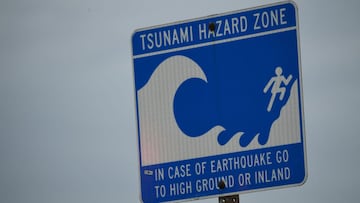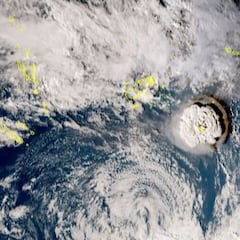Why do tsunamis happen in the Pacific Ocean?
Tsunamis can be incredibly destructive as a wave of water surges onshore carrying all but the most solid objects inland, so what causes them?

The massive wave surge happens whenever a large amount of water is displaced, whether by something falling into the ocean or the land underneath being displaced. Tsunamis happen around the globe, but they occur most frequently around the Pacific and Indonesia.
Around 80 percent of tsunamis occur in the Pacific Ocean because of the extensive tectonic plate activity present there. The powerful natural phenomenon can affect any area along a large body of water, and extremely destructive tsunamis have occurred in the Atlantic and Indian Oceans, as well as the Mediterranean Sea.
Also see:
- Earth's sixth mass extinction has begun according to scientists
- Tiny volcanic island in Tonga sparks tsunami warnings
- Bill Gates makes hopeful projection on the end of the pandemic
- How astronaut twins smuggled a gorilla suit aboard the ISS
Tsunamis are not like other ocean waves
Tsunamis should not be confused with “tidal waves” which are caused by the tides which rise and fall due to the gravitational force of the Moon. Nor are they like regular ocean waves that are produced by the wind and storms. Powerful storms such as hurricanes can produce surges that penetrate far inland but tsunamis are a different beast.
Unlike normal waves, they don’t normally break in a curling action. They are more akin to a fast-moving tide, traversing the open ocean at up to 500 miles per hour. In deep water the ocean may rise just a foot or so but when they reach shallow water the wave begins to slow and swell. When a tsunami reaches the shore, it can push far inland flooding coastal areas for hours.
What causes tsunamis?
Large underwater earthquakes that shift the seabed in a vertical direction are the primary trigger for this destructive natural phenomenon. But landslides, either underwater or portions of land or ice falling into the ocean, volcanic eruptions and meteor impacts can also produce a tsunami.
Because of the high number of subduction zones under the Pacific Ocean and Indonesia, these areas are more prone to experiencing these awe-inspiring forces of nature. The highly geologically active region is known as “the Ring of Fire” due to the high concentration of volcanoes around the Pacific Ocean and across the Indonesian archipelago.
Tsunamis can range in size from the imperceivable to monstrous waves that can raze nearly everything in their path. The highest reliably recorded tsunami occurred in 1958 in Alaska when a massive landslide fell into Lituya Bay. The resulting wave that crashed into the other side of the bay was 1,700 feet high.
Destructive tsunamis throughout history
Related stories
There have been numerous tsunamis throughout history but one of the most destructive and deadliest in recorded history was the 2004 Boxer Day Tsunami in the Indian Ocean. An earthquake with a magnitude in the range of 9.1 to 9.3 off the coast of Sumatra in Indonesia produced waves over 100 feet high. It resulted in almost 230,000 people either dead or missing around the Indian Ocean.
The Lisbon earthquake of 1755 produced a tsunami almost 50 feet high that destroyed the city and ravaged the coasts of the Iberian Peninsula and Northern Coast of Africa. The flooding and subsequent fire resulted in the death of perhaps 50,000 people and is credited with starting modern seismology.

